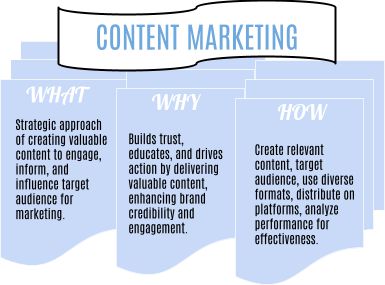Case Study: How a Startup Leveraged Content Marketing to Achieve Remarkable Results
If you’re reading this blog, our attempt in content marketing has been successful! We have employed a
bunch of steps to reach out to you. Why- wouldn’t be an ideal question. Ask us how and you’ve got the
answer once you scroll down.
So, is content marketing just this? A bunch of words thrown around that hardly pool in a reader or
two? Certainly not. It’s like saying only painting is art- what about literature , music, movies, architecture,
sculpting and dancing? Likewise, blogs are just one part of content marketing. Where does it begin and
what does it end with?
See all those WH- questions popping up! We will explore the answers to it together!
Introduction
Content marketing is the efforts put forward by business brands to reach out to the potential
consumers, carrying the goal of establishing trust and awareness, of attracting and engaging the audience
and creating a unique outlook of the concerned brand, and by using means that suit the strategy of the
company and of the target demand, to drive financial gain. Simply put, content marketing is the steps
taken to ensure your brand sells, but more importantly, leaves an impression.
The loyalty base that is cultivated through content marketing is the capital for any startup’s long term business goals. The increasing likeness that the brand should carry, can be sustained and driven using many models of contents and through various platforms like blog posts, video contents, published articles, podcasts, emails, social media contents, virtual events and user generated content.
Then, If the product retains quality and the demand is seen to be on the rise and there is appropriate allocation towards advertising, what is the need of all these shenanigans?! Because your business, in the technological, globalized and competitive era is as transient as that reel you just watched, liked, swiped and forgotten! Content marketing thus, revolves around the ultimate goal of reminding the consumers of your product, its relevance and its quality value. Your brand needs to not be a hyped up trend but a constant online presence.
The loyalty base that is cultivated through content marketing is the capital for any startup’s long term business goals. The increasing likeness that the brand should carry, can be sustained and driven using many models of contents and through various platforms like blog posts, video contents, published articles, podcasts, emails, social media contents, virtual events and user generated content.
Then, If the product retains quality and the demand is seen to be on the rise and there is appropriate allocation towards advertising, what is the need of all these shenanigans?! Because your business, in the technological, globalized and competitive era is as transient as that reel you just watched, liked, swiped and forgotten! Content marketing thus, revolves around the ultimate goal of reminding the consumers of your product, its relevance and its quality value. Your brand needs to not be a hyped up trend but a constant online presence.

Here are some points to ponder before you manage to overlook its importance:

- Consumers are the king, but content is the queen.
- The optimization of the audience’s power to choose should be included in your marketing strategy.
- Constant engagement in the market is of ultra-importance, on par with the demand.
- Competition should not wipe you out, and that is why a based presence is required.
- The imprint of your brand can be left behind using techniques of communication.
- The ultimate goal is to convert the viewer base into long term customers.
- It is easy to get lost in the traffic of the web, and the only way to sustain it is through infiltrating into the psyche of the consumer through appropriate data analytics and search engine marketing.
From Startup to Sensation: Pepperfry's Success in 15 Points
Initiated in 2011 by Ambareesh Murthy and Ashish Shah, Pepperfry reinterpreted home decor in the
Indian markets. Ranging to above one million furniture designs and household products, Pepperfry rose as
a brand label, being one of the early entrants in the online home decor retail market in the country. It has
its market presence in over 500 cities and towns at present.
Pepperfry adhered to a customer- first approach as an extension of which they included features for quick returns, installation solutions, and simulated furniture tryouts.
Pepperfry adhered to a customer- first approach as an extension of which they included features for quick returns, installation solutions, and simulated furniture tryouts.
Pepperfry’s wins:
- Identifying product requirement gaps in the furniture shifting menace and the lack of virtual shopping stores in the Indian sites
- Combining this with fashionable presentation of their product range, not only on the shelves but in settings that gave the impression of elevating the quality of homes.
- Digital marketing campaigns were in the forefront, including tactically placing their home decor or introducing furniture in the storyline of a web series, advertisements, usage of virtual reality technology and marketing through traditional and digital media
- Pepperfry Blogs were maintained to communicate with the audience on home decor solutions, furniture placements, on contemporary trends and organization and styling techniques.
- Presence in social media including Facebook, Twitter, Instagram, YouTube and intelligently on Pinterest too and through subscription activities and customized email newsletters.
- Collaborated with celebrities and influencers, and released home makeover videos, furniture assembly guidelines and product experiences and ratings.
- Studio Pepperfry was inaugurated in over 60 Indian metropolitans to showcase their products as experience centers to try out their products before investing in it.
- Partnered with Quikr to facilitate furniture exchange.
- Used interactive tools while product purchase placement and by introducing a Pepperfry Shopping App inclusive of augmented reality features
- In the aggressive campaigning, they also set up educational webinars and modified contents using SEO optimisation.
Conclusion

In the coming years, Pepperfry is planning to go public. Not only was the venture’s core not shaken
during the pandemic, it made a remarkable comeback by the mid-2020, thanks to the intense digital
adaptation of the country and the conscience of home as a primary source of impression during the WFH
era. As a result, its sales volume surpassed its pre-Covid sales by a huge margin of 50-60%.
By active digital involvement and catering to the search-related needs, Pepperfry became one of the e-commerce businesses to deliver non-essential category large products at the doorsteps. All the content was targeted towards addressing the challenges of Covid and for providing tips, entertaining with trivias, quizzes and trends.
Pepperfry teaches the budding startup owners to focus on the activeness of the brand itself, despite the consumer behavior. Human emotions and psyche play a key role in the shopping experience, it is essential that businesses act respecting these and by having patience. Consumers in demand should come to you, rather than you doing hardsell. Invest in the content wisely and the wise pickers will choose you.
Let’s part our ways by manifesting what Pepperfry slogan reads-
‘HAPPY FU(rni)TURE TO YOU’!
By active digital involvement and catering to the search-related needs, Pepperfry became one of the e-commerce businesses to deliver non-essential category large products at the doorsteps. All the content was targeted towards addressing the challenges of Covid and for providing tips, entertaining with trivias, quizzes and trends.
Pepperfry teaches the budding startup owners to focus on the activeness of the brand itself, despite the consumer behavior. Human emotions and psyche play a key role in the shopping experience, it is essential that businesses act respecting these and by having patience. Consumers in demand should come to you, rather than you doing hardsell. Invest in the content wisely and the wise pickers will choose you.
Let’s part our ways by manifesting what Pepperfry slogan reads-
‘HAPPY FU(rni)TURE TO YOU’!





